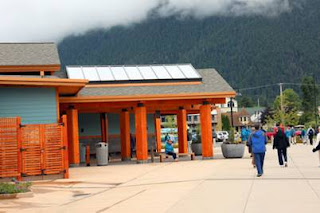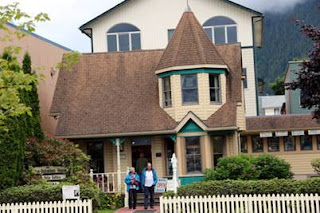Sixty years later, the Russians had depleted the sea otter population, almost to the point of extinction. These lush pelts were considered "soft gold", as they were worth ten times more in China as they were in Alaska. This is when Secretary of State, William Seward, bought Alaska from Russia for $7.2 million dollars in 1867. That computed to a mere 2 cents per acre…..incredible buy, for sure. Hard to believe that transaction was considered "Seward's folly". And who would have guessed that in 1880, a gold mine of precious metals was discovered in Juneau and other cities? To mark the 150 year of this transaction, there was a celebration recently in Alaska for the Sesquicentennial purchase.
Furthermore, by 1968, liquid gold was discovered in Prudhoe Bay…..of course, that "gold" was oil. An amazing engineering feat crossing three mountain ranges and three fault lines was created called the Trans-Alaska Pipeline. It was designed to take an 8.5 earthquake, as well as temperatures that dip as low as 80 degrees below zero. We personally known many friends that went to work on that pipeline in the 60's, making darn good money doing extremely difficult work.
Shore excursions sold wildlife, sightseeing, and adventure tours here today…..a total of 21 of them. What can you hope to see here? For tours costing $130 to $180, you can see sea otters, whales, sea lions, porpoise, and harbor seals. Less likely to be spotted are brown bear and black-tail deer, unless you visit the Fortress of the Bears, a refuge, like a zoo, where you are guaranteed to see the captive animals or you get a refund.
Adventure tours ran from $60 to $500 for 2 to 7 ½ hours. They included hiking, kayaking, jet boating, rafting, 4x4 drive, and a dry suit snorkel. Really? The $500 tour was fishing for salmon and halibut with a $25 license fee and a King salmon stamp for $15.
For easy excursions, sightseeing was $60 to $90 for 2 ½ to 3 ½ hours. The most amusing activity was a pedal and pub crawl. You joined 15 other people on a bike built for 16. Two beers were included, with an option to buy two more. Pedaling after 4 beers must have been a hoot, since the town is built on a hillside, some of it rather steep.
We were not alone today….the Seabourn Sojourn was anchored in the bay near downtown. Tender boats were running right into town, unlike us, where we had to bus 7 miles from the commercial pier. Probably worked out the same in the long run.
There are two highlights in Sitka, which are easily accessible on foot, if you like to walk. One is the Alaska Raptor Center, a 17 acre rehabilitation center for bald eagles and golden eagles. There are also a few hawks, falcons, and owls that had been injured or orphaned, and cannot be released into the wilds. The fee to see these birds is $12. We have been there on past cruises, so decided to spend most of our time at the second highlight.
That turned out to be the Sitka National Historical Park, the oldest national park unit in Alaska. Part of the fun is walking there from the bus drop off spot. Heading along the coastline, we passed by the shops in town, and followed the map to the Russian Bishop's House. This original log house was built in 1843, and is one of the last Russian colonial houses left in North America. Touring the house costs $4, where you can learn the history of the Russian Orthodox Church's beginnings in Alaska.
Passing the local College, Sheldon Jackson and a museum, we came upon the Sitka Sound Science Center & Aquarium. There is a fish hatchery in the back, as well as the creek where some salmon come up a river. We have seen them during their run in September, and the numbers were immense.
Entering the park, there is a collection of most impressive totem poles. They are some of the finest displays in all of Alaska, as well as up to 100 years old. Allowed to deteriorate naturally, these totems would have been lost forever. So now, replicas have been created by local native artists, then shipped to this spot. Next to them is a complete explanation of what they represent. They can be for one person, family, clan, or as a marker for a grave. These single totems with one figure on the top often had cremated remains of that person in a hidden box built into the back of the pole itself.
This well laid out park has 113 acres with at least 2 miles of trails. They weave in between the forest of dense shade with trees of cedar, spruce, alder, and hemlock trees. Park rangers conduct guided walks during the tourist season. At the headquarters, you can pick up brochures with maps and excellent info. Besides restrooms, there are exhibits of native arts, wood and precious metal carvings, and robe, basket, and bead weavings. There were a few items for sale connected to this park, but there was also a table with pamphlets and park buttons with the 150th year acquisition of Alaska to the US. These were free….one per customer.
We must have spent two hours exploring the trails, reading and photographing the totems, and enjoying the view of the shoreline and the Sojourn anchored across from us. Many benches and picnic tables were placed along the edge of the forest, where you can sit and keep an eye out for eagles. Being patient paid off, since we saw several.
This park is also known for a battle between the local tribes and the Russians in 1802, where many were massacred. On September 28, 1804, the Russians came back and re-took the fortress. Recently, a special totem monument was dedicated to this war, marking the Battle of Sitka.
Close by, we rounded the point, and found that we were at the mouth of the Indian River. This is where tens of thousands of pink salmon run upstream to spawn. Animals that frequent the area are brown bear, river otter, mink, martens, Sitka deer, and 150 species of birds. No bears today, but when the salmon run begins, they will come.
As much as we hated to leave, all aboard was at 3:30pm. So we headed back towards the visitor center, and back-tracked to the center of town. We had one more place to see, and that was the Russian Cemetery, located uphill from St. Michael's Cathedral. With its copper-clad domed roofs, this Russian Orthodox Church was built in 1848. Having burned down in 1966, what we see today is a replica. Right up the streets from here, is the cemetery. A very old one, with wooden crosses as well as some modern stones. The rocky path was narrow, damp, and steep, so we did not last too long, as we were totally alone up here. With the ravens crowing, it left us with an eerie feeling.
Time to head back to town, and search out that pizza we heard about from a local young lady. The pizza did not happen, since the restaurant was not exactly what we were looking for. This was more like fast food dining. The nicest-looking place was the Westmark Sitka Hotel overlooking the harbor. There was a patio on the second floor as well as tables inside. It was not too crowded when we arrived, but by 2pm, the place had a long line waiting for tables. We ordered two beers – Alaskan White draft. Perfect. Then we shared a French dip prime rib roast beef sandwich (delicious), and ended the meal with one slice of mud pie. What a way to end our last visit in Alaska for this trip.
Many buses were lined up to take people back to the Amsterdam. It was only a 15 minute ride at the most. We did not have time to shop in town, but we did check out the few shops in the cruise terminal. There were no bargains here at all, unless you didn't mind paying some big bucks for luxurious fur jackets and fur-lined boots.
We had lucked out with the weather today. Despite the prediction of rain, it never did. It remained overcast, but not too cold. At the sail out of the bay, the winds picked up, and we were glad we had our arctic jackets on. There were a few sightings of eagles, but really far away. Hoping to see whales, we were disappointed that we did not. However we did see a small group of otters, although they were far away as well.
Joining our lively tablemates, we enjoyed another fine dinner. Once again, the entire dining room had emptied out, and we were among the last to leave. The bad news was that the clocks had to be set forward, losing a precious hour. Bedtime turned out to be well after 1am for one of us. Good thing tomorrow is a sea day.
Bill & Mary Ann
 Place for bed and breakfast inns
Place for bed and breakfast inns
 There are eagles perched in these trees
There are eagles perched in these trees
 Small islands dot the coastline in this bay
Small islands dot the coastline in this bay
 Birds seem to like these islets
Birds seem to like these islets
 Mostly cloudy day, but no rain
Mostly cloudy day, but no rain
 Whales are usually in this area
Whales are usually in this area
 Working on a tender boat (we never used them this trip)
Working on a tender boat (we never used them this trip)
 Buildings near the commercial harbor
Buildings near the commercial harbor
 Tour boat for wildlife viewing
Tour boat for wildlife viewing
 Fresh Dungeness crab served here
Fresh Dungeness crab served here
 Pricy, but dangerously delicious they advertised
Pricy, but dangerously delicious they advertised
 A tender boat from the Seabourn Sojourn
A tender boat from the Seabourn Sojourn
 Visitor's center – the bus stop
Visitor's center – the bus stop
 Fish ladder at the science center
Fish ladder at the science center
 Sheltered spot for small craft
Sheltered spot for small craft
 One example of a fishing vessel
One example of a fishing vessel
 Some salmon will come up these ladders
Some salmon will come up these ladders
 Between one and four years old
Between one and four years old
 Will get adult feathering at 5 years old
Will get adult feathering at 5 years old






























































